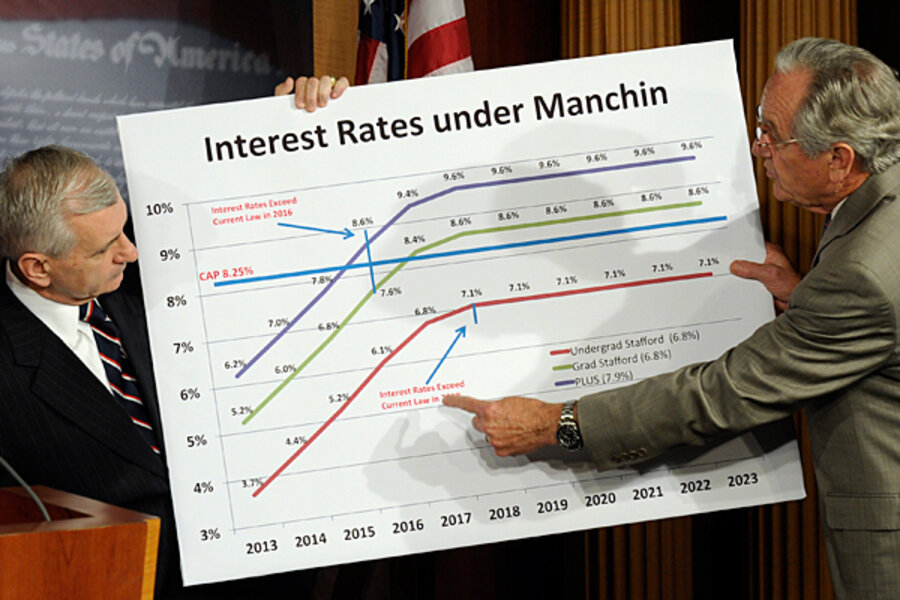Student loans: Despite new proposals in Congress, no fix as deadline looms
Loading...
| Washington
Congress is deadlocked over what to do with student-loan interest rates, meaning rates on some subsidized student loans will double come July 1.
This is despite a flurry of proposals, including at least two on Thursday alone. Nevertheless, Congress is set to break for 10 days away from Washington without a fix, meaning students looking to finance their college education will be uneasily waiting for Congress to get its act together before the fall semester.
But so far, there’s little prospect of compromise even when lawmakers return after the Independence Day recess. Congressional Democrats, for example, are posturing that they won’t bend to a bipartisan proposal that would stabilize rates now but could lead to higher rates in the future.
“Students around this country would rather have no deal than a bad deal,” said Sen. Jack Reed (D) of Rhode Island, a sponsor of the main Democratic proposal to fix student-loan rates.
The clash on the Hill illuminates a deep policy divide between the two parties with heavy political overtones.
In May, House Republicans passed a measure that, like President Obama’s budget proposal, calls for a long-term student-loan fix that pegs interest rates to the cost that the federal government incurs to borrow money.
In general, House Republicans and a bipartisan Senate group want to solve the student-loan problem once and for all – and solve it now.
This bipartisan Senate group consists of three Republicans and two Democrats, and they offered a student-loan compromise on Thursday: It would affect all federal student loans, pegging subsidized and unsubsidized undergraduate student-loan rates to the 10-year Treasury note, plus 1.85 percent, and adding 3.4 percent for graduate loans and 4.4 percent for additional “PLUS” loans.
Interest rates would, unlike the House proposal, stay fixed for the life of each loan and could be consolidated at 8.25 percent when a student leaves higher education.
The five senators backing this proposal are among the most exasperated with the Senate’s current state of deliberation – patching many programs year after year without solving problems. (The student-loan issue has been punted down the field each of the past two years.)
“We’re notorious for not fixing anything. We’re notorious for kicking the can down the road,” said Sen. Joe Manchin (D) of West Virginia on Thursday. “We’ve said, enough is enough.”
Such a fix would be “the only thing that’s certain up here,” said Sen. Tom Coburn (R) of Oklahoma, “other than chaos.”
This bipartisan proposal appears to hold appeal for the GOP-held House. Rep. John Kline (R) of Minnesota, the chair of the Education and the Workforce Committee and shepherd of the student-loan bill that the House passed last month, stayed engaged with the bipartisan group’s talks and was “encouraged” by the final product, according to a spokesman.
But Senate Democrats, among them some of the body’s leading liberals, want a one-year extension of current rates because they see student loans as an integral piece of a bigger problem: the skyrocketing cost of higher education and the crushing student-loan burden those costs have impressed on young people.
A one-year fix, they reason, would pave the way for student loans to be reconsidered along with the forthcoming reauthorization of the Higher Education Act in the fall.
As such, a sextet of liberals unveiled their own, one-year fix on Thursday. It would keep subsidized student loans (40 percent of all federal loans) at 3.4 percent for the coming year and offset the cost by changing tax rules on some retirement accounts – something sure to rile up Republicans. (The proposal would do nothing to lower the other 60 percent of loans, which are reduced in the bipartisan proposal, compared with current interest rates.)
Democrats feel they’ll be able to pressure their Republican counterparts to come around to a short-term fix, coupled with the promise of long-term reform, for reasons of both policy and politics. First, the bipartisan proposal, they say, will make things more expensive for students in the long run.
Sen. Tom Harkin (D) of Iowa called the bipartisan proposal a “classic bait and switch,” pointing out that the Congressional Budget Office forecasts that under this proposal, all three classes of federal student loans would rise above 6.8 percent by 2016 – the level to which subsidized rates would double without a fix.
Also, while votes on similar bills from both sides failed earlier in June, Democrats feel that they’ll eventually corner the GOP politically into a one-year extension of loan rates because conservatives will eventually bend on a high-profile pocketbook issue.
“This is a reasonable proposal that last year, in an election year, the Republicans went for,” said Sen. Elizabeth Warren (D) of Massachusetts.
But even some in the Democrats’ own caucus just can’t stand the thought of kicking the can one more time.
“It’s another delay,” said Sen. Angus King (Ind.) of Maine, who caucuses with the Democrats and who is a cosponsor of the bipartisan loan package. “What will we know in a year that we don’t know now? So let’s solve the problem.”







